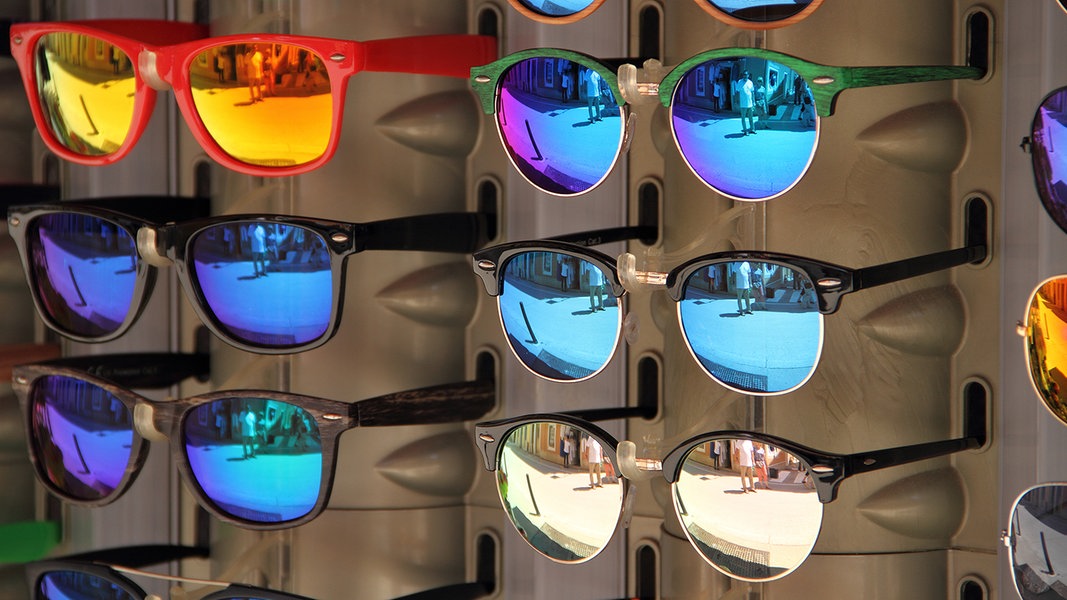Status: 06/16/2023 12:02 p.m
Sunglasses are designed to protect eyes from dangerous UV-A and UV-B rays. Which offer sufficient protection? What is important when it comes to UV filtering, the shape and quality of the lenses?
The sun’s rays can damage not only the skin, but also the eyes. Possible consequences of UV-A and UV-B rays are inflammation of the cornea or conjunctiva, clouding of the lens (cataracts) and even cancer. Experts also suspect a connection between the sun’s rays and the development of macular degeneration. To prevent damage to the eyes, one should wear sunglasses in strong sunshine. This also applies to children, because their eyes are particularly sensitive to UV radiation.
How Sunbeams Harm the Eye
In the eye, the lens absorbs most of the UV-A and UV-B rays. Proteins change in the process, so that the lens can become cloudy in the long term. A small part of the long-wave UV-A radiation hits the retina through the lens. If extremely strong radiation strikes unfiltered for longer than 30 seconds, a photochemical reaction occurs: the photoreceptors are destroyed. Looking directly at the sun, for example when observing a solar eclipse, can lead to acute, irreversible damage within seconds. In so-called snow blindness, the cornea burns within hours.
But a so-called sunburn in the eye, which usually heals after about one or two days, is also unpleasant. Typical symptoms are red, burning or painful eyes and blurred vision after being in the sun. If you suspect sunburn, it is better to consult a doctor to avoid permanent damage to the eye. Ointments and eye drops can relieve symptoms.
UV radiation on the water is particularly high
Good sun protection for the eyes is important at the sea because the water reflects the light.
You should therefore protect your eyes well, especially on the beach and in the water. The danger is particularly great in water sports: the so-called surfer’s eye is a proliferation of the conjunctiva that often occurs as a result of intense sunlight on the water. Because there the light not only comes from above, but is reflected by the water surface from all sides. As a result of the extreme UV exposure, the conjunctiva proliferates beyond the cornea. If the growth becomes too large, it must be removed.
Filtering: Pay attention to UV400 standard and infrared protection
For effective sun protection, sunglasses should filter out all UV rays up to a wavelength of 400 nanometers. Such glasses can be recognized by the inscription “UV400” or “100 percent UV protection”. The marking assures the buyer that the glasses protect the eyes from harmful UV rays.
In addition, additional infrared protection is recommended, especially for places where the sun’s rays are particularly intense, such as by the sea or in the snow. The CE mark, on the other hand, must be worn by all sunglasses sold in Germany: it shows that there is at least UV protection up to 380 nanometers and that the product complies with the applicable EU directives. However, this information is not verified by any independent body.
Shape: Sunglasses should cover eyes completely
Sunglasses should sit in such a way that they cover the eyes as completely as possible and also prevent radiation from the side. It should also be as close to the eyes as possible. Wider temples protect against stray light from the side.
Dark tint does not automatically mean UV protection
When buying, you should pay attention to UV and infrared protection and the fit, the color of the lenses is a matter of taste.
The tint of the lenses says nothing about the UV protection. But bright light dazzles the eyes and makes them tire more quickly. The brighter the light, the darker the glasses should be. Manufacturers distinguish five categories from 0 for very little tint to 5 for very dark. High-quality glasses contain a polarizing filter that reduces light reflections and ensures a clearer image. The color of the lenses is a matter of taste. Orange-colored glasses make all green appear richer and increase contrasts. They are not suitable for road traffic because they alienate signs and warning lights.
Testing the quality of the lenses: Are lines distorted?
The quality of the glasses is shown, among other things, by the fact that they have no inclusions or irregularities. Objects must not appear distorted or bent, as this can lead to headaches. A simple test before you buy: hold the glasses at a distance in front of your face and aim for a straight line. With slight movements of the glasses, the line should not be distorted.
Older sunglasses often do not have sufficient UV protection
Be careful with older models of glasses: They often let a large part of the UV rays through and should be replaced, because our pupils open behind dark glasses and let more rays into the eye. The retina is then at the mercy of you without any protection. It is better not to wear sunglasses than ones with poor UV protection. You can have an optician measure whether your existing sunglasses really protect you.
Further information
Any exposure to the sun increases the risk of skin cancer. With the right protection, you can enjoy the summer. more
This topic in the program:
market | 06/19/2023 | 8:15 p.m
